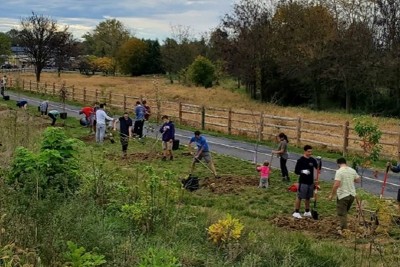
to support the community tree canopy. Photo courtesy City of Harrisonburg.
Harrisonburg Public Works won the Gold Medal Governor’s Environmental Excellence Award for its Urban Forestry and Urban Wood program.
The awards, presented by the Virginia Department of Environmental Quality, recognize significant contributions of environmental and conservation leaders in the categories of sustainability, environmental project, greening of government and implementation of the Virginia Outdoors Plan. The Harrisonburg Urban Forestry and Urban Wood program being honored this year is an effort by the Public Works team to make the best out of a bad situation with our community’s ash trees, and the program has quickly become an example for others across the Commonwealth to follow.
The effort gives new life to trees that have been removed from our tree canopy due to the invasive emerald ash borer, which infests ash trees and eventually kills them, creating a serious safety hazard from trees that could fall in areas like our parks. More than 1,000 ash trees have been removed in Harrisonburg, but Jeremy Harold, greenspace manager for the Public Works Department, quickly realized that those trees didn’t have to just go to waste.
Working closely with Virginia Department of Forestry staff, Harold helped to start the Harrisonburg Urban Wood Program.
“Instead of putting the tree through a chipper, the program creates a better use for the felled wood by repurposing it for a second life at their highest value: such as turning top branches into mulch, turning bottom branches into firewood, and using trunks for lumber,” Harold explained.
The program has utilized more than 1,000 tons of natural resources as woodchips, firewood and lumber, with the lumber especially being a much sought-after resource for local woodcrafters. The lumber also is used in City projects such as benches, planter boxes, solar kiln, display boards, tables, coasters and much more, which often offsets the need to purchase other raw material.
Around 300 tons of wood debris annually was diverted from the landfill through the Urban Wood Program since its creation, and to date the program has generated 10,500 board feet of lumber, 1,000 cubic yards of mulch and 15 pallets of firewood.
But with every tree that comes down, Public Works knows a new tree needs to go up. And with up to 14 percent of public trees being ash, the need to begin replacing these trees became imperative.
That’s why Harrisonburg’s Urban Forestry Program replaces every ash tree with a diverse selection of native species with no more than 10 percent of one species. More than 1,400 diverse native trees have been planted in Harrisonburg parks, along city streets, adjacent to streams and other city rights-of-way since 2018.
Trees are an essential component to habitat and conservation in urban areas. As smaller forests are connected through planned or informal urban greenways, trees provide essential habitat to a range of birds, pollinators, and other wildlife that feed on insects.
The Urban Forestry program seeks to maintain and grow the city’s urban forests through planting diverse native species and species most likely to be acclimated to a changing climate. Hundreds of these trees are grown by staff in our greenhouses, helping to reduce costs and transportation emissions.
The program reuses felled trees, keeping them out of the landfills where they generate greenhouse gases while providing material for city projects and local businesses that reduce the need for virgin materials and transportation related emissions. Additionally, the trees help to reduce stormwater and improve water quality while also acting as air filters and sequestering carbon.
The program partners with community groups, businesses and residents, and seeks to work across City departments and programs to expand tree canopy coverage into neighborhoods with limited tree coverage, helping to improve tree equity measures. For example, the Urban Forestry program has partnered with the city’s stormwater cost share program, Harrisonburg Conservation Assistance Program, to provide high-quality tree planting plans and advice for landowners interested in trees while the HCAP program provides financial support to the landowners.
“It is important that all of our residents have access to trees because trees provide so many benefits from water quality, habitat, and carbon sequestration to reducing the impacts of the urban heat island effect,” said Keith Thomas, sustainability and environmental manger at the Public Works Department.










